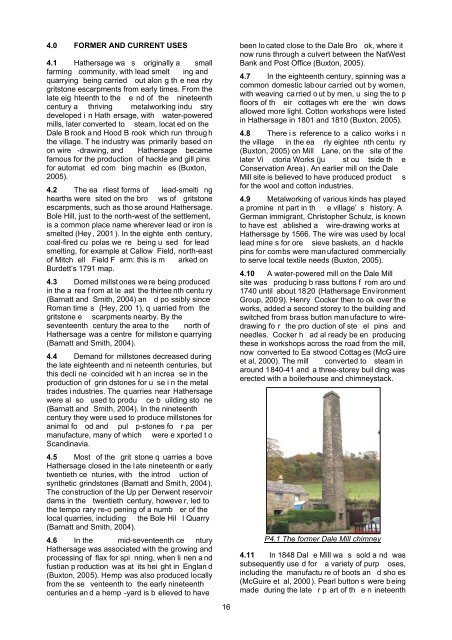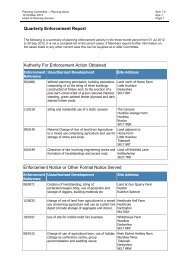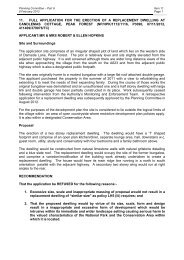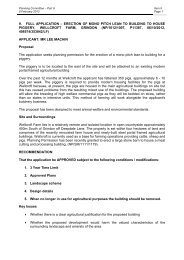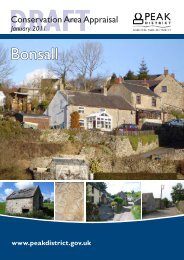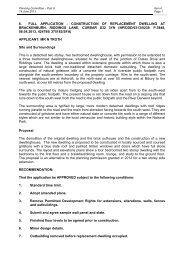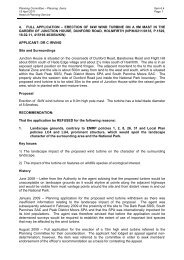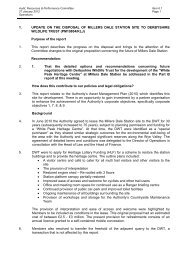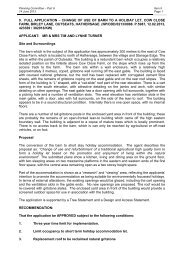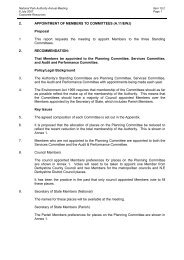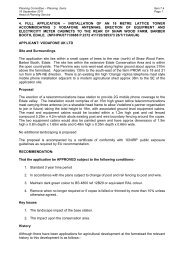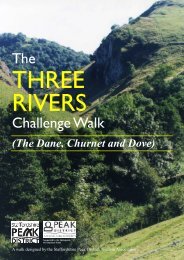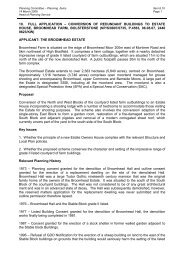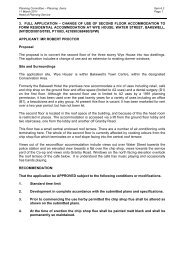Appendix - Peak District National Park Authority
Appendix - Peak District National Park Authority
Appendix - Peak District National Park Authority
Create successful ePaper yourself
Turn your PDF publications into a flip-book with our unique Google optimized e-Paper software.
4.0 FORMER AND CURRENT USES4.1 Hathersage wa s originally a smallfarming community, with lead smelt ing andquarrying being carried out alon g th e nea rbygritstone escarpments from early times. From thelate eig hteenth to the e nd of the nineteenthcentury a thriving metalworking indu strydeveloped i n Hath ersage, with water-poweredmills, later converted to steam, locat ed on theDale B rook a nd Hood B rook which run throug hthe village. T he industry was primarily based onon wire -drawing, and Hathersage becamefamous for the production of hackle and gill pinsfor automat ed com bing machin es (Buxton,2005).4.2 The ea rliest forms of lead-smelti nghearths were sited on the bro ws of gritstoneescarpments, such as tho se around Hathersage.Bole Hill, just to the north-west of the settlement,is a common place name wherever lead or iron issmelted (Hey , 2001 ). In the eighte enth century,coal-fired cu polas we re being u sed for leadsmelting, for example at Callow Field, north-eastof Mitch ell Field F arm: this is m arked onBurdett’s 1791 map.4.3 Domed millst ones we re being producedin the a rea f rom at le ast the thirtee nth centu ry(Barnatt and Smith, 2004) an d po ssibly sinceRoman time s (Hey, 200 1), q uarried from thegritstone e scarpments nearby. By theseventeenth century the area to the north ofHathersage was a centre for millston e quarrying(Barnatt and Smith, 2004).4.4 Demand for millstones decreased duringthe late eighteenth and ni neteenth centuries, butthis decli ne coincided wit h an increa se in theproduction of grin dstones for u se i n the metaltrades industries. The quarries near Hathersagewere al so used to produ ce b uilding sto ne(Barnatt and Smith, 2004). In the nineteenthcentury they were u sed to produce millstones foranimal fo od and pul p-stones fo r pa permanufacture, many of which were e xported t oScandinavia.4.5 Most of the grit stone q uarries a boveHathersage closed in the l ate nineteenth or earlytwentieth ce nturies, with the introd uction ofsynthetic grindstones (Barnatt and Smit h, 2004).The construction of the Up per Derwent reservoirdams in the twentieth century, howeve r, led tothe tempo rary re-o pening of a numb er of thelocal quarries, including the Bole Hil l Quarry(Barnatt and Smith, 2004).4.6 In the mid-seventeenth ce nturyHathersage was associated with the growing andprocessing of flax for spi nning, when li nen a ndfustian p roduction was at its hei ght in Englan d(Buxton, 2005). Hemp was also produced locallyfrom the se venteenth to the early nineteenthcenturies an d a hemp -yard is b elieved to have16been lo cated close to the Dale Bro ok, where itnow runs through a culvert between the NatWestBank and Post Office (Buxton, 2005).4.7 In the eighteenth century, spinning was acommon domestic labour carried out by women,with weaving ca rried o ut by men, u sing the to pfloors of th eir cottages wh ere the win dowsallowed more light. Cotton workshops were listedin Hathersage in 1801 and 1810 (Buxton, 2005).4.8 There i s reference to a calico works i nthe village in the ea rly eightee nth centu ry(Buxton, 2005) on Mill Lane, on the site of thelater Vi ctoria Works (ju st ou tside th eConservation Area) . An earlier mill on the DaleMill site is believed to have produced product sfor the wool and cotton industries.4.9 Metalworking of various kinds has playeda promine nt part in th e village’ s history. AGerman immigrant, Christopher Schulz, is knownto have est ablished a wire-drawing works atHathersage by 1566. The wire was used by locallead mine s for ore sieve baskets, an d hacklepins for combs were man ufactured commerciallyto serve local textile needs (Buxton, 2005).4.10 A water-powered mill on the Dale Millsite was producing b rass buttons f rom aro und1740 until about 1820 (Hathersage EnvironmentGroup, 200 9). Henry Cocker then to ok over th eworks, added a second storey to the building andswitched from brass button man ufacture to wiredrawingfo r the pro duction of ste el pins andneedles. Cocker h ad al ready be en producingthese in workshops across the road from the mill,now converted to Ea stwood Cottag es (McG uireet al, 2000). The mill converted to steam inaround 1840-41 and a three-storey buil ding waserected with a boilerhouse and chimneystack.P4.1 The former Dale Mill chimney4.11 In 1848 Dal e Mill wa s sold a nd wassubsequently use d for a variety of purp oses,including the manufactu re of boots an d sho es(McGuire et al, 2000). Pearl button s were beingmade during the late r p art of th e n ineteenth


